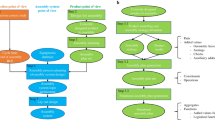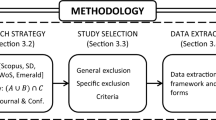Abstract
When developing assembly cells with highly complex modular structures, designers need to translate user requirements into a set of design rules and potential cell configurations. The success in matching user requirements to potential products is dependent on how well the functional and non-functional customer requirements can be understood and translated into cell features (design rules, processes and module types). This paper reports on a knowledge based methodology for forming customisable re-configurable assembly cells. The approach is based on matching user requirements to existing supplier knowledge in terms of design rules and principles, modules offered by different vendors, new emerging technologies and existing own and competitors’ products. The decision making includes requirements analysis, generating assembly processing alternatives and evaluating and selecting assembly modules and cells. The proposed approach aims to assist decision making in assembly system design by enabling users and suppliers to jointly participate in an interactive and iterative process of forming re-configurable assembly cells.
Similar content being viewed by others
Explore related subjects
Discover the latest articles and news from researchers in related subjects, suggested using machine learning.References
Belecheanu R., Pawar K.S., Barson R.J., Bredehorst B., Weber F. (2003). The application of case based reasoning to decision support in new product development. Integrated Manufacturing Systems, 14(1): 36–45
Boumans, R. (1999). Industrial end-user requirements for requirements and knowledge management tools. In Proceedings of ICE’99. The Hague, Netherlands
Chung C., Peng Q. (2004). The selection of tools and machines an web-based manufacturing environments. International Journal of Machine Tools and Manufacture, 44, 317–326
Delchambre, A. (1996). CAD method for industrial assembly: Concurrent design of products, equipment and control systems. Chichester, West Sussex, UK: John Wiley & Sons.
Easterbrook S.M. (1991). Elicitation of requirements from multiple perspectives. PhD Thesis Imperial College of Science Technology and Medicine, University of London
Gardan N., Gardan Y. (2003). An application of knowledge based modelling using scripts. Expert Systems with Applications, 25, 555–568
Grabowik C., Knosala R. (2003). The method of knowledge representation for a CAPP system. Journal of Materials Processing Technology, 133, 90–98
Hirani, H., & Ratchev, S. (2002). Definitions and measures for requirements engineering of reconfigurable assembly systems. In Proceedings of the 31st international symposium on robotics. Stockholm, Sweden.
Hollis, R., & Quaid, A. (1995). An architecture for agile assembly. In Proceedings of ASPE’99. Austin, TX.
Kotonya G., Sommerville I. (1998). Requirements engineering: Processes and techniques. Chichester, West Sussex, UK, John Wiley & Sons
Lee, B. H., & Ishii, K. (1996). Product-agents and the embedded web: Architectures and tools for lifecycle design. In Proceedings of Workshop 8: Agents and web-based design environments. Stanford University, CA.
Lindvall M., Rus I., Sinha S.S. (2003). Software systems support for knowledge management. Journal of Knowledge Management, 7(3): 137–150
Lottaz, C., & Smith, I. (1997). Collaborative design using constraint solving, research poster, Swiss Federal Institute of Technology (EPFL), Lausanne, Switzerland.
Maturana F.P., Norrie D.H. (1996). Multi-agent mediator architecture for distributed manufacturing. Journal of Intelligent Manufacturing, 7, 257–270
Nonaka I., Takeuchi H. (1999). The knowledge creating company – How Japanese companies create the dynamics of innovation. Oxford, UK, Oxford University Press
Rampersad H. (1994). Integrated simultaneous design for robotic assembly. Chichester, West Sussex, UK, John Wiley & Sons
Ratchev, S. (1998). Resource capability modelling for responsive process planning in extended manufacturing facilities. In: Globalisation of manufacturing in the digital communications era of the 21st century (pp. 389–400). Boston: Kluwer Academic Publishers.
Ratchev, S., Pawar, K. S., & Struck, T. (1999). The KARE methodology, KARE-knowledge acquisition and sharing for requirement engineering. EU ESPRIT Project Report.
Ratchev S., Urwin E., Muller D., Pawar K.S., Moulek I. (2003). Knowledge based requirement engineering for one-of-a-kind complex systems. Knowledge-Based Systems, 16, 1–5
Schreiber G. (1999). Knowledge engineering and management – The CommonKADS methodology. Cambridge, MA, The MIT Press
Stanford University, http://protege.stanford.edu, Protégé Ontology Editor and Knowledge Acquisition System, 2nd February 2005.
Author information
Authors and Affiliations
Corresponding author
Rights and permissions
About this article
Cite this article
Ratchev, S.M., Hirani, H. & Bonney, M. Knowledge based formation of re-configurable assembly cells. J Intell Manuf 18, 401–409 (2007). https://doi.org/10.1007/s10845-007-0031-y
Received:
Accepted:
Published:
Issue Date:
DOI: https://doi.org/10.1007/s10845-007-0031-y




